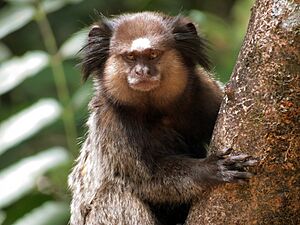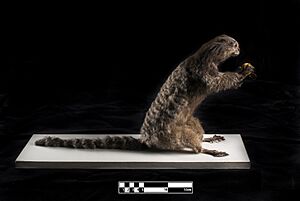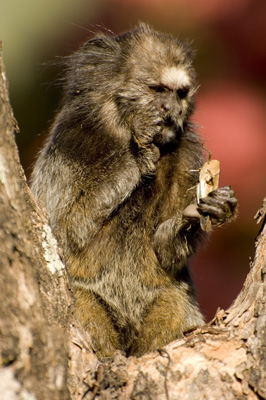Black-tufted marmoset facts for kids
Quick facts for kids Black-tufted marmoset |
|
|---|---|
 |
|
| Conservation status | |
| Scientific classification | |
| Genus: |
Callithrix
|
| Species: |
penicillata
|
 |
|
| Geographic range | |
| Synonyms | |
|
|
The black-tufted marmoset (also called Callithrix penicillata) is a small New World monkey. In Brazilian Portuguese, it's known as Mico-estrela. These monkeys live mostly in the forests of central Brazil. You can find them from Bahia down to Paraná. They also live inland in Goiás. They are often seen in Rio de Janeiro, where they were brought by people. Black-tufted marmosets usually live high up in rainforest trees. They rarely come down to the ground.
Contents
What They Look Like
The black-tufted marmoset is easy to spot. It has black tufts of hair around its ears. Its face often has a few white hairs. The head is usually brown or black. Its arms, legs, and upper body are gray. The belly is also gray, but its back and underside are black.
Tail and Hands
Its tail has black and white rings. The tail helps the marmoset balance in trees. It cannot grab things with its tail. Black-tufted marmosets do not have a thumb like humans. Their nails look more like claws. These marmosets are about 7.48 to 8.7 inches (19.0 to 22.1 centimetres) long. They weigh up to 12.35 oz (350 g).
How They Live
Black-tufted marmosets are active during the day. They spend most of their time in trees. They live in family groups. A group usually has 2 to 14 marmosets. These groups often include a mother and father. Their young offspring also live with them.
Family Life
It is common for these marmosets to have twins. The males and older young often help raise the babies. Even though they live in small family groups, they might share food. They share sap trees with other marmoset groups.
Communication and Travel
Marmosets use scent marking to mark their area. This marking might keep other animal species away. Other marmoset groups often ignore these marks. They seem to move around depending on the wet or dry seasons. We don't know how far they travel.
Marmosets talk to each other using different sounds. They have special calls for predators. They also make many other sounds.
What They Eat and Who Eats Them
Black-tufted marmosets mostly eat tree sap. They get sap by biting the tree bark. They use their long lower teeth for this. When it's dry, they also eat fruit and insects. If there is a serious drought, they might eat other small creatures. This includes spiders, snails, bird eggs, and baby birds. They also eat small animals with backbones.
Predators
Large birds of prey are the biggest danger to marmosets. Snakes and wild cats also hunt them. Marmosets use special calls to warn about predators. They also look around carefully to spot danger. These are their main ways to stay safe.
Having Babies
Black-tufted marmosets usually have one partner for life. They live in family groups. They have babies twice a year. They can have 1 to 4 babies, but twins are most common. The mother carries the babies for about 150 days. The babies drink milk for 8 weeks.
Raising the Young
Both parents help a lot with raising the young. Older brothers and sisters also help. The babies depend on their parents for a long time. They are ready to have their own babies at 18 months. But they usually stay with their family longer. They wait until they are older to find a partner.
Their Role in Nature and Protection Status
Black-tufted marmosets help fruit trees. They spread seeds from the fruits they eat. This helps new trees grow in the forest. But they can also harm some trees. They make holes in trees to get sap. This doesn't seem to help the trees.
Conservation Status
The black-tufted marmoset is not considered endangered. It is listed as "Least Concern" by the IUCN Red List. This means they are not currently at risk. They are also listed in Appendix II of CITES. This means their trade is controlled to prevent them from becoming endangered.
In Rio de Janeiro State, these marmosets were brought in by people. They are now considered an invasive species. They compete with the endangered golden lion tamarin. This competition can harm the tamarin's survival. To help, people have suggested ways to manage the marmosets. This includes stopping them from having more babies. They also move some marmosets to other places. Public campaigns help people understand not to release them.




